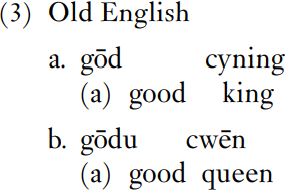


 Grammar
Grammar
 Tenses
Tenses
 Present
Present
 Past
Past
 Future
Future
 Parts Of Speech
Parts Of Speech
 Nouns
Nouns
 Verbs
Verbs
 Adverbs
Adverbs
 Adjectives
Adjectives
 Pronouns
Pronouns
 Pre Position
Pre Position
 Preposition by function
Preposition by function 
 Preposition by construction
Preposition by construction
 Conjunctions
Conjunctions
 Interjections
Interjections
 Grammar Rules
Grammar Rules
 Linguistics
Linguistics
 Semantics
Semantics
 Pragmatics
Pragmatics
 Reading Comprehension
Reading Comprehension|
Read More
Date: 2023-10-21
Date: 2023-08-24
Date: 2023-11-20
|
Agreement is found inside noun phrases and, in some of the IndoEuropean languages of Europe, in the copula constructions – adjective complements of BE (and other copula verbs) agree with the subject noun. Agreement in noun phrases is exemplified in (1).


The phrases in (1a–c) could function as subjects of clauses. Reks in (1a), regina in (1b) and oppidum in (1c) are said to be in the nominative case, the case being signaled by the suffixes -s, -a and -um. The adjective translated as ‘great’ consists of the stem magn-[as in ‘magnify’ – to make great] plus various suffixes, -us, -a and -um. Which suffix is added is controlled by the head noun. *Magna reks is incorrect, as is *magnus regina. The nouns in (1a–c) have singular number; different suffixes appear both on the nouns and the adjectives when they are plural, as in (2).

The nouns in (2) are still in the nominative case and can still function as the subjects of clauses, but they are plural and have different suffixes, and the adjectives too have different suffixes. Whether, for example, the stem magn- takes the suffixes -us, -a, -i or -ae depends on what type of noun it modifies, what case the noun is in and whether the noun is singular or plural. That is, the noun is the controlling word but both noun and adjective change shape, that is, change their suffixes; this is why the term ‘agreement’ is used. The traditional formula is that adjectives agree with nouns in number and case (and also in gender, which is discussed below.) In spite of the traditional formula, we can view the noun as governing the adjective in case and number.
Old English had similar patterns of agreement between the head noun in a noun phrase and adjectives that modified it. Consider the examples in (3).


The nouns in (3) are in the nominative case. Cyning in (3a) is masculine, and scip in (3c) is neuter. The adjective in both examples consists of the stem go¯d, with no suffix. Cwe¯n in (3b) is feminine, and the adjective takes the suffix -u, go¯du. A richer pattern is observed when the head noun is plural, as in (4).

The masculine plural noun cyningas in (4a) is modified by go¯de with the suffix -e. The feminine plural noun cwe¯na in (4b) is modified by go¯da, with the suffix -a. Finally, in (4c) the neuter plural noun scipu is modified by go¯du, with the suffix -u. Although the adjective and noun in (3a) and (3b) do not change their shape, since no suffixes are added to the stem, all the nouns and adjectives in (4) do change their shape, since suffixes are added to both adjective and noun. Looking at the overall pattern for singular and plural, and for other cases, we can justifiably speak of adjective and noun agreeing in Old English.
|
|
|
|
4 أسباب تجعلك تضيف الزنجبيل إلى طعامك.. تعرف عليها
|
|
|
|
|
|
|
أكبر محطة للطاقة الكهرومائية في بريطانيا تستعد للانطلاق
|
|
|
|
|
|
|
أصواتٌ قرآنية واعدة .. أكثر من 80 برعماً يشارك في المحفل القرآني الرمضاني بالصحن الحيدري الشريف
|
|
|